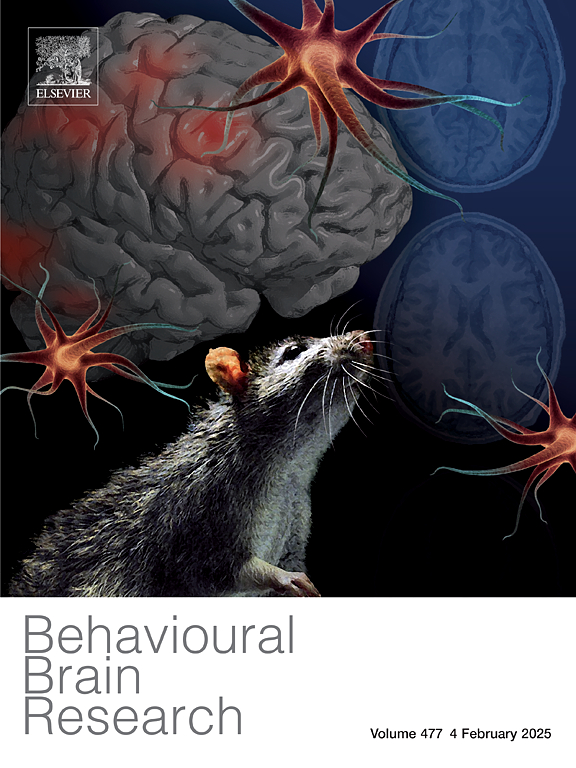Different subregions of the anterior cingulate cortex differentially regulate acute itch-scratching behavior in rats
IF 2.3
3区 心理学
Q2 BEHAVIORAL SCIENCES
引用次数: 0
Abstract
Numerous studies in both humans and rodent models have consistently demonstrated the important role of the anterior cingulate cortex (ACC) in emotion perception, pain processing, memory formation, etc. The ACC can be anatomically subdivided into rostral and caudal subregions, each exhibiting distinct functional profiles. Previous studies have provided robust evidence supporting the involvement of the ACC as a whole in pruritus regulation; however, the specific regulatory effects exerted by the distinct subregions of the ACC on pruritus remain unknown. In this study, we investigated the impact of rostral ACC and caudal ACC neuronal intervention on scratching behavior in rats with acute experimental histaminergic and nonhistaminergic itch. The results demonstrated that activation of ACC neurons occurs during acute itching. Moreover, pharmacogenetic inhibition of the rostral ACC increased acute itch scratching induced by 5-hydroxytryptamine (5-HT), whereas inhibition of the caudal ACC reduced both 5-HT- and Compound 48/80-induced acute itch-scratching behavior. In conclusion, the rostral ACC exerts a negative modulatory effect on itch, whereas the caudal ACC plays a positive modulatory role. Both subregions are implicated in the modulation of nonhistaminergic itch, whereas only the caudal ACC is involved in the modulation of histaminergic itch.
前扣带皮层的不同亚区对大鼠急性痒抓行为的调节存在差异
在人类和啮齿动物模型中进行的大量研究一致证明了前扣带皮层(ACC)在情绪感知、疼痛处理、记忆形成等方面的重要作用。ACC在解剖学上可以细分为吻侧和尾侧亚区,每个亚区都表现出不同的功能特征。先前的研究提供了强有力的证据,支持ACC作为一个整体参与瘙痒的调节;然而,ACC的不同亚区对瘙痒的具体调节作用尚不清楚。在这项研究中,我们研究了吻侧ACC和尾侧ACC神经元干预对急性实验性组胺性和非组胺性瘙痒大鼠抓挠行为的影响。结果表明,ACC神经元的激活发生在急性瘙痒期间。此外,对吻侧ACC的药理学抑制增加了5-羟色胺(5-HT)诱导的急性瘙痒,而对尾侧ACC的抑制则减少了5-HT和化合物48/80诱导的急性瘙痒行为。综上所述,吻侧ACC对瘙痒有负调节作用,而尾侧ACC对瘙痒有正调节作用。这两个亚区都与非组胺能性瘙痒的调节有关,而只有尾侧ACC参与组胺能性瘙痒的调节。
本文章由计算机程序翻译,如有差异,请以英文原文为准。
求助全文
约1分钟内获得全文
求助全文
来源期刊

Behavioural Brain Research
医学-行为科学
CiteScore
5.60
自引率
0.00%
发文量
383
审稿时长
61 days
期刊介绍:
Behavioural Brain Research is an international, interdisciplinary journal dedicated to the publication of articles in the field of behavioural neuroscience, broadly defined. Contributions from the entire range of disciplines that comprise the neurosciences, behavioural sciences or cognitive sciences are appropriate, as long as the goal is to delineate the neural mechanisms underlying behaviour. Thus, studies may range from neurophysiological, neuroanatomical, neurochemical or neuropharmacological analysis of brain-behaviour relations, including the use of molecular genetic or behavioural genetic approaches, to studies that involve the use of brain imaging techniques, to neuroethological studies. Reports of original research, of major methodological advances, or of novel conceptual approaches are all encouraged. The journal will also consider critical reviews on selected topics.
 求助内容:
求助内容: 应助结果提醒方式:
应助结果提醒方式:


